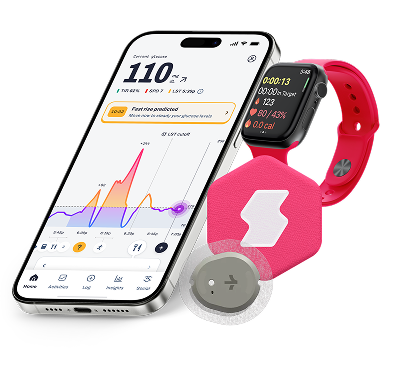Brown sugar is a common sweetener in many households, known for its rich flavor and soft texture. It is a product derived from sugarcane or sugar beet, combined with molasses, which gives it a distinct color and taste. Despite its appealing properties, brown sugar possesses a moderately high glycemic index, making it important for those monitoring their blood sugar levels.¹ ²
This article will explore the glycemic index of brown sugar and its implications for diet and health.
Sign up to be the first to know about special offers and exciting Signos news.
Glycemic Index Table
The glycemic index (GI) for brown sugar is typically around 64, classifying it as a medium-GI food.¹ The GI signifies how quickly a food can raise blood sugar levels, and brown sugar, being moderately high, can lead to faster glucose spikes compared to foods with a lower GI, such as whole grains or legumes. Unlike some foods, the GI of brown sugar remains consistent regardless of how it's used in cooking, as it primarily serves as a sweetening agent with no significant compositional changes in its carbohydrate structure.
To calculate the glycemic load (GL) of brown sugar, use the formula: GL = (GI × Carbohydrate per serving) ÷ 100. For brown sugar with a GI of 64 and a serving size of 100g (carbohydrate content being 100g), the GL per serving is as follows:
GL = (64 × 100) ÷ 100 = 64.² The glycemic load provides a more complete picture of how a portion of food impacts blood sugar levels, considering both the quality (GI) and quantity of carbohydrates consumed. This is particularly important for those managing conditions like diabetes, where both GI and GL can influence dietary choices.

Nutritional Facts
Brown sugar, typically consumed in a 100g serving size, contains around 375 calories, all derived from carbohydrates, which total 100g.² It lacks protein, fiber, cholesterol, sodium, and fats, making it purely a caloric source from sugars with no significant micronutrients or other macronutrients. The absence of vitamins and minerals such as calcium, iron, or potassium highlights its limited nutritional value, primarily serving as a sweetening ingredient rather than a source of essential nutrients.² Given its high carbohydrate content and glycemic index, moderate consumption is advised for individuals monitoring blood sugar levels.¹
The nutritional information below is for 100g of brown sugar.
Nutritional Facts

Is Brown Sugar Good for Weight Loss?
Brown sugar is not typically recommended for weight loss, as it is high in calories and lacks essential nutrients.² While it adds flavor, it provides no fiber or protein to enhance satiety, making it easy to overconsume without feeling full. Moderation is crucial if included in a weight management plan, as excess intake can contribute to calorie surplus and weight gain. Consider substituting with natural sweeteners like fruits or using smaller amounts to reduce caloric intake while maintaining desired sweetness.
Is Brown Sugar Good for People Living with Diabetes?
Brown sugar is not ideal for people living with diabetes due to its high glycemic index and load, which can cause rapid spikes in blood sugar levels.¹ Individuals with diabetes should exercise caution and consider alternatives like sweeteners with lower glycemic impacts, such as stevia or erythritol. Managing portion sizes and balancing carbohydrate intake with fiber-rich foods can help mitigate blood sugar fluctuations. Consulting with a healthcare professional or nutritionist can provide personalized advice for incorporating sweeteners safely into a diabetic diet.
Better health starts here.
Sign up for tips and insights that work for you!
Allergies
Allergies to brown sugar are uncommon but can occur, often linked to underlying allergies to sugarcane or sugar beet. Allergic reactions may manifest as oral allergy syndrome (OAS), where individuals experience itchiness or swelling in the mouth, lips, or throat after consuming brown sugar. In severe instances, symptoms could escalate to hives, difficulty breathing, or even anaphylaxis. The sensitivity usually arises from proteins present in the sugarcane or beet plant, not from the sugar itself. If you suspect an allergy, sensitivity, or intolerance to brown sugar, it is crucial to consult a healthcare professional.

References
References
- Glycemic Index. (2023). https://glycemicindex.com/
- USDA FoodData Central. (2023). https://fdc.nal.usda.gov/




.svg)
.svg)
.svg)
.svg)
.svg)
.svg)
.svg)
.svg)
